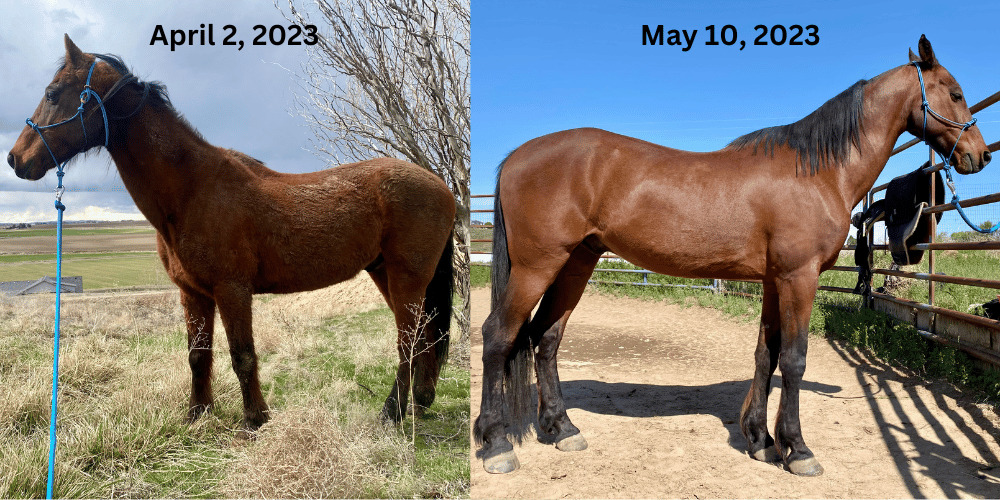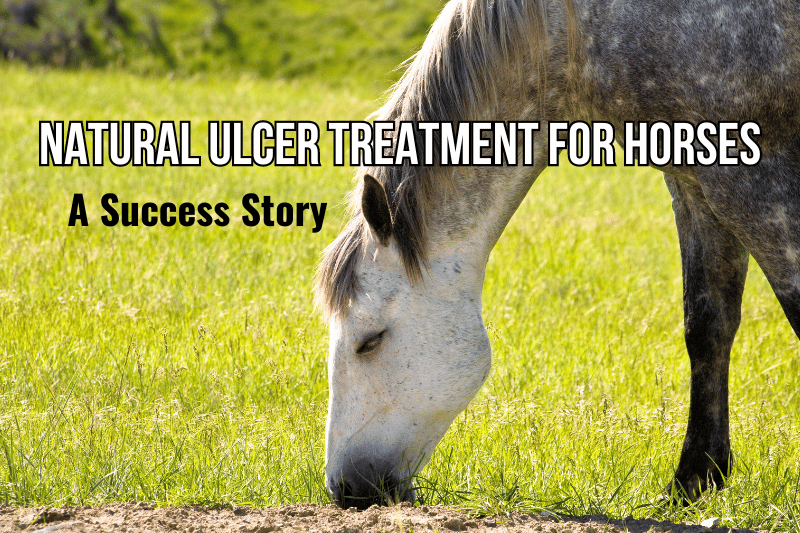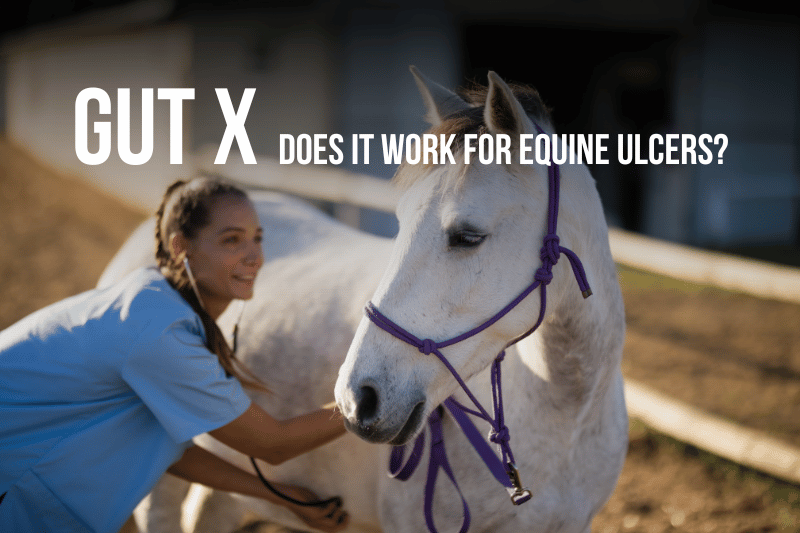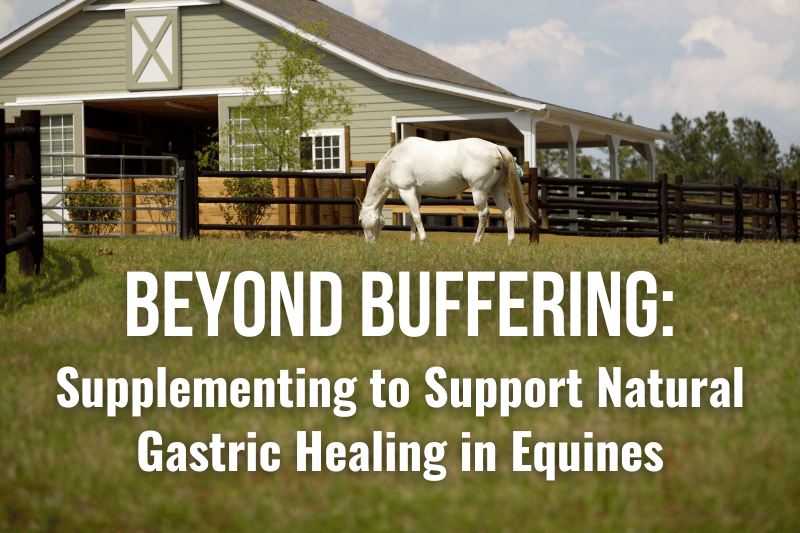You suspect your horse has ulcers. You take him to the vet and get him scoped. Next thing you know, you’re being offered a $1,200 case of GastroGard and a warning that acid rebound can occur when you discontinue the drug.
Gulp.
Surely there must be a natural ulcer treatment for horses…right?
This post describes how I used natural ulcer treatments to get my rescue horse’s guts comfortable after omeprazole failed. I’ll cover management decisions, why I chose two natural ulcer supplements, and what I’d do differently next time.
How I Treated My Horse's Ulcers Naturally After Omeprazole Failed
My rescue horse, Pixar, is a National Show Horse who came to me ribby and tense beneath his rough haircoat. He jumped at the breeze and paced his paddock fence constantly. At feeding time, he approached eagerly but turned away after the smallest nibble.
On a good day, Pixar would consume just a few pounds of grass hay and alfalfa – not nearly enough for what should have been a 1,000 pound horse.
My vet took one look at Pixar and agreed with me that he “screamed ulcers.” We were sure enough to skip the gastroscopy and go straight to treatment.
Attempt 1: Abler Omeprazole
I tried Abler’s omeprazole product first.
Abprazole is a lot cheaper than GastroGard, and I didn’t really want to spend more than necessary on this unexpected addition to my herd. Unfortunately, Pixar wouldn’t touch any kind of pelleted feed. That meant I couldn’t get the granules into him the easy way, as a top-dressing.
You’re not supposed to get Abprazole granules wet because moisture can break down the enteric coating before it gets to the horse’s stomach. I risked it anyway in various attempts to syringe the drug by mixing it with applesauce, corn oil, and banana baby food.
No dice. The granules just clogged the syringe and didn’t make it into the horse.
Attempt 2: UlcerGard Omeprazole
Sighing and muttering about how “free horses aren’t free,” I moved on to the official treatment protocol. I used UlcerGard instead of GastroGard because it’s exactly the same product, just marked with prevention doses rather than treatment doses and available without a prescription.
I administered the treatment dosage of UlcerGard for 30 days. To maximize absorption, I dosed Pixar each morning before feeding, then waited an hour to give him hay.
I’m used to seeing an ulcery horse’s behavior change by the time it’s been on omeprazole for a week. Pixar, though? Hardly a difference over the entire month.
Some horses do require more than a month’s treatment with omeprazole to achieve full healing of gastric ulcers. It’s possible that, had I continued the treatment, Pixar would have improved. However, I’d seen so little difference in him that I opted for another route.
Attempt 3: Natural Ulcer Treatment
I tapered Pixar off UlcerGard over about a week to mitigate the dreaded acid rebound effect.
Wondering if the bigger problem might be glandular or hindgut ulcers (which omeprazole doesn’t fix and might even exacerbate), I pondered my options. Sucralfate, ranitidine, and misoprostol all have their pros and cons.
At this point, Pixar still scarcely cleaned up enough food to keep a pony healthy, let alone a big-boned NSH. Our young relationship was suffering from all that syringe-dosing. And let’s be honest: I didn’t love the idea of another vet bill.
Time to try the natural route.
Feed and Turnout
I decided my top priority was to get calories into Pixar while minimizing his stress level.
That meant giving him the only thing he’d eat reliably: green grass. I hoped that 24/7 pasture turnout would also ease his emotional state, plus I could keep all our training interactions syringe-free.
For a couple weeks, all Pixar ate was grass and a few bites of the alfalfa that I kept available to him at all times. Alfalfa’s high protein and calcium content has a buffering effect on the equine stomach. Of course, that only helps if the horse will eat it.
I faced the same problem with supplements: Pixar still wouldn’t eat any sort of pellets or powders, so ulcer supplements just sat untouched in his bowl.
And then, we had a breakthrough.
One afternoon, I had some soaked beet pulp left over and thought, “What the heck, let’s see if Pixar wants it.” Miraculously, he did!
I was shocked because I normally have to convince horses that sloppy, gray shreds of soaked beet pulp are actually food. Most of them love it once they agree to try, but to my amazement, Picky Pixar dove right in.
I immediately began offering him several pounds of soaked beet pulp per day, in addition to his pasture and free-choice alfalfa. I mixed stabilized rice bran into the beet pulp to add calories that, unlike grains, wouldn’t exacerbate ulcers.
At first, he’d eat the mash slowly, leaving and coming back to repeatedly it over many hours. Within a week, though, he began eating bigger meals. He was feeling better!
As a bonus, I now had a way to feed him supplements. Which ones should I choose?

Ulcer Supplements for Horses
A quick sweep of the internet will reveal dozens of ulcer supplements for horses.
Ranging from single-ingredient natural substances to commercial pellets, a person could spend a lifetime – not to mention a life’s savings – trying them all. Even the cheap ones (aloe, pectin, Gut X, which I wrote about in detail here, etc.) add up if you use them long enough to know whether they help.
As I dug into the world of natural ulcer supplements for horses, I kept some criteria in mind. The product had to be:
- Affordable
- Palatable
- Easy to feed
- Low sugar
- Supported by research, ideally on the product itself (not just its ingredients)
As it turns out, there are some natural ulcer supplements whose efficacy has at least some scientific backing. These include glutamine and slippery elm for supporting the intestinal mucus barrier, licorice to decrease inflammation, and more. Other common recommendations, like seabuckthorn berry, have shown mixed results.
Across the supplement smorgasboard, research in horses is limited. We can try to extrapolate from rat and human studies, but must do so with full awareness that we are only guessing as to whether the equine gut will respond similarly.
Two Natural Ulcer Supplements I Selected
Faced with a panoply of questionable ingredients, it’s tempting to throw the kitchen sink at the problem. This is a terrible idea, however. Not only is it going to get expensive, but if one of the multiple supplements you’re giving your horse does work, you won’t know which one it is.
I dealt with this by looking for supplements formulated with multiple ingredients that have at least some evidence backing their efficacy. The two candidates that rose to the top of my list were SmartGI Ultra from SmartPak and Visceral+ from Mad Barn.
SmartGI Ultra and Visceral+ have some overlapping ingredients, including familiar faces in the natural ulcer supplement world like lecithin, L-Glutamine, marshmallow root extract, and saccharomyces cerevisiae yeast.
Each product also contains a number of ingredients that the other doesn’t, with SmartGI Ultra having a higher total number of ingredients. The use of proprietary blends in both supplements makes a complete apples-to-apples comparison impossible because I can’t tell how much of every ingredient is in a serving.
So, to the research! What do actual studies have to say about the efficacy of the products themselves, as opposed to their component ingredients?
SmartGI Ultra, SmartGut Ultra, and SmartDigest Ultra by SmartPak
SmartGI Ultra combines the ingredients in SmartGut Ultra and SmartDigest Ultra, both of which have some research behind them.
A study on SmartGut Ultra, which was partly funded by the manufacturer, used gastroscopy to demonstrate that the product helps protect horses’ stomachs from acid rebound after treatment with omeprazole. The product appears to help prevent recurrence of ulcers following cessation of GastroGard without changing stomach pH.
A study on SmartDigest Ultra and SmartGI Ultra, funded by a company that produces the postbiotic yeast ingredient they contain, found that the products improved production of Volatile Fatty Acids.
According to the study summary, VFAs are “a major source of energy for the horse [and] help maintain the health of the cecum and colon by supporting cell growth, blood flow, and the normal secretory and absorptive functions of the intestine.”
The beneficial effect was more pronounced in SmartGI Ultra than in SmartDigest Ultra. Note that this study focused on general hindgut health, not on ulcers per se.
If you decide to try SmartGI Ultra, will you use my link? It helps support this blog as a free resource, at no extra cost to you. I appreciate it so much!
Visceral+ by Mad Barn
Visceral+ by Mad Barn also targets both stomach and hindgut health. It was studied by an independent vet clinic specifically for efficacy in horses with gastric ulcers.
As in the SmartGut Ultra study, horses in the Visceral+ study were treated with GastroGard, then given the supplement starting a week or two before the omeprazole treatment stopped. They were evaluated by gastroscopy after 60 days and all showed either improved or resolved ulcers. Unfortunately, the study summary on this page indicates that no control group was used.
You can read my interview with an equine nutritionist about Visceral+ here.
Disappointingly, none of these studies answer my real question: Would the supplements help heal ulcers in a horse that wasn’t treated with omeprazole first?
As far as I’m aware, we just don’t know. However, spontaneous healing of equine ulcers can occur, and it makes sense that supporting the horse’s natural healing mechanisms would help.
I supplemented Pixar with SmartDigest Ultra in the morning and Visceral+ in the evening for two weeks. After that, I discontinued the SmartDigest and kept on with Visceral+ alone.
Whether it was the turnout, the feed, the supplements, or the combination, Pixar’s health, weight, and behavior improved dramatically on his natural ulcer treatment regime. He has continued to do well without drugs for 11 months and counting, even after my pasture dried up for summer and we had to switch back to hay.
Does Natural Ulcer Treatment for Horses Work?
Natural ulcer treatment seemed to work for Pixar when omeprazole didn’t.
It’s possible that the drug got him pointed in the right direction and the natural treatment just finished the job. It’s also possible that I could have gone straight to the natural protocol and saved myself a wad of cash.
If I had it to do over, with the benefit of hindsight, here’s what I think I would do:
- Hold off treating with omeprazole at first.
- Start with 24/7 turnout with green grass, free choice alfalfa, and beet pulp with rice bran.
- Supplement with SmartGI Ultra or Visceral+.
- If improvement was not notable after six weeks, I’d consider gastroscopy and treatment with GastroGard (or other treatments recommended by my vet).
In summary:
Natural ulcer treatment is likely to take longer than drug treatment, and it may or may not work. The same goes for omeprazole, but your chances are arguably better with the drug, assuming you manage the risk of acid rebound.
Natural treatment might be cheaper…but then again, it might not. Supplements add up. If you have to change your horse’s living situation, you could be looking at real money – maybe more than that case of UlcerGard.
Either way, once you get those ulcers under control, it is clear that natural preventative measures make recurrence less likely.
How to Prevent Ulcers in Horses
Here are the steps I take, year-round, with all my horses, to prevent ulcers:
- Frequent or constant access to forage. Green grass would be ideal, but it’s not an option on my non-irrigated property, so I use a mix hay that is about 80% orchard grass and 20% alfalfa.
- Minimize grain in the diet, replacing it with fat (flax, stabilized rice bran, or low-starch pellets) to add calories when needed.
- Feed before exercise. I let my horses munch alfalfa from a hay net while tacking up.
- Feed while trailering.
- Feed Purina Outlast before exercise or other stressors, like travel.
- Promote drinking with plenty of clear water and supplementary salt in cold or wet weather.
- Supplement with SmartGI Ultra or Visceral+ to support natural gut protection and healing mechanisms.
- Minimize stressors such as stall confinement, incompatible neighbors, and changes in the home environment.
You might also like
This post includes affiliate links, and I may earn a small commission (at no extra cost to you) when you purchase through these links. I only recommend products and services I think are helpful and useful. Thanks for helping me offset the cost of maintaining this blog as a free resource!






Hello!
I’m curious to learn more about your experience with Visceral. My sweet young gelding is battling EPM which also brought about ulcers. Unfortunately, I am no stranger to them. He is being treated with omeprazole and misoprostol. I am looking into gut support after the RX meds are DQ’d. I use Outlast for hauling or conditioning rides, but Visceral has recently landed on my radar. I am actually about to be a Mad Barn convert for my feed protocol as well. Are you using Visceral daily? Or as needed? On all of your horses? I have 4 and I highly doubt that I can afford to put all 4 on Visceral.
All of his needs are met: He has 24/7 turn out, an all forage diet, ad lib hay, and alfalfa.
Sorry you’re struggling with your guy! 🙁 I use Visceral daily in horses that are under stress (new to the farm, in training, conditioning for endurance) but take them off it when they aren’t stressed (like over winter). Ideally, I’d keep everybody on it year round, but as you pointed out, that gets expensive!
Stay tuned — I’m looking into writing a more comprehensive post about Visceral+ because several readers have requested it, and I’m curious to learn more myself.
Thanks for your response. I am still trying to determine the best course of action. I will absolutely read your report and look forward to seeing it post.